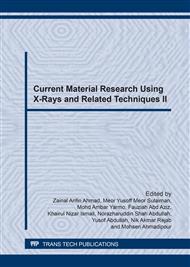[1]
Information on www. coatingsys. com.
Google Scholar
[2]
M.A. Fox, M.T. Dulay, Heterogeneous photocatalysis, Chem. Rev. 93 (1993) 341-357.
Google Scholar
[3]
K.P. Priyanka, J. Sunny, T.S. Anu, O.P. Jaseentha, V. Thomas, Surface modification of nanotitania using high energy electron beam irradiation, Int. J. of Emerg. Technol. and Adv. Eng. 2(11) (2012) 130-134.
Google Scholar
[4]
H. Kominami, J. I Kato, S.Y. Murakami, Y. Kera, M. Inoue, T. Inui, B. Ohtani, Synthesis of titanium (IV) oxide of ultra-high photocatalytic activity: High-temperature hydrolysis of titanium alkoxides with water liberated homogenously from solvent alcohol, J. Mol. Catal. A Chem. 144(1) (1999).
DOI: 10.1016/s1381-1169(98)00350-1
Google Scholar
[5]
D. Monllor-Satoca, R. Gomez, M. González-Hidalgo, P. Salvador, The direct-indirect, model: An alternative kinetic approach in heterogeneous photocatalysis based on the degree of interaction of dissolved pollutant species with the semiconductor surface, Catal. Today, 129(1-2) (2007).
DOI: 10.1016/j.cattod.2007.08.002
Google Scholar
[6]
G. Wang, Hydrothermal synthesis and photocatalytic activity of nanocrystalline TiO2 powders in ethanol–water mixed solutions, J. Mol. Catal. A, 274 (1-2) (2007) 185-191.
DOI: 10.1016/j.molcata.2007.05.009
Google Scholar
[7]
S. Sahni, B. Reddy, B. Murty, Influence parameters on the synthesis of nano-titania by sol-gel route, Mater. Sci., Eng. A, 452-453 (2007) 758-762.
DOI: 10.1016/j.msea.2006.11.005
Google Scholar
[8]
M. Francisco, V. Mastelaro, Inhibition of the anatase-rutile phase transformation with addition of CeO2 to CuO-TiO2 system: Raman Spectroscopy, XRD and textural studies, Chem. Mater. 14 (6) (2002) 2514-2518.
DOI: 10.1021/cm011520b
Google Scholar
[9]
L.O. Jing, Z.L. Xu, J. Shang, W. Cai, The surface properties and photocatalytic activities of ZnO ultrafine particles, Appl. Surf. Sci. 180 (2001) 308-314.
DOI: 10.1016/s0169-4332(01)00365-8
Google Scholar
[10]
E.M. Mahdi, M. Hamdi, M.S. Meor Yusof, The effect of sintering on the physical and optical properties of nano-TiO2 synthesized via a modified hydrothermal route, Arabian J. for Sc. and Tech. 38 (7) (2013) 1701 – 1711.
DOI: 10.1007/s13369-012-0384-1
Google Scholar
[11]
L. Jing, S. Li, S. Song, L. Xue, H. Fu, Investigation on the electron transfer between anatase and rutile in nano-sized TiO2 by means of surface photo voltage technique and its effects on the photocatalytic activity. Solar Energy Mater Solar Cells, 92 (2008).
DOI: 10.1016/j.solmat.2008.03.003
Google Scholar
[12]
M. Francisco, V. Mastelaro, Inhibition of the anatase-rutile phase transformation with addition of CeO2 to CuO-TiO2 system: Raman Spectroscopy, XRD and textural studies, Chem. Mater. 14 (6) (2002) 2514-2518.
DOI: 10.1021/cm011520b
Google Scholar
[13]
S. Valencia, J.M. Marin, G. Restrepo, study of the bandgap of synthesized titanium dioxide nanoparticules using the sol-gel method and a hydrothermal treatment, The Open Mat. Sc. Journals 4 (2009) 9-14.
DOI: 10.2174/1874088x01004020009
Google Scholar
[14]
K.M. Reddy, S.V. Manorama, A.R. Reddy, Bandgap studies on anatase titanium dioxide nanoparticles, Mater. Chem. and Phys. 78 (2002) 239 – 245.
DOI: 10.1016/s0254-0584(02)00343-7
Google Scholar
[15]
A.V. Krasheninniov, K. Nordlund, Ion and electron irradiation-induced effects in nanostructured materials, J. of Appl. Phys. 107 (2010) 071301.
Google Scholar
[16]
D. Do, S.D. Mahanti, Bonds, bands and bandgaps in tetrahedrally bonded ternary compounds ; The role of group V lone pairs, cond-mat. mtrl-sci in press (2013) 1 – 17.
DOI: 10.1016/j.jpcs.2013.12.004
Google Scholar


